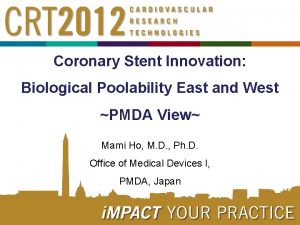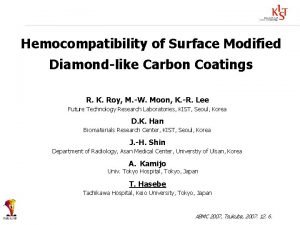Treatment of recurrent instent restenosis with secondgeneration drug

- Slides: 1

Treatment of recurrent in-stent restenosis with second-generation drug -coated balloons: a 2 -center experience. Bernardo Cortese 1, Pedro Silva Orrego 1, Davide Piraino 1, 2, Dario Buccheri 1, 2, 2 1 Giuseppe Andolina , Romano Giuseppe Seregni. 1 A. O. Fatebenefratelli, Milano, Italy, 2 A. O. U. P. Paolo Giaccone, Palermo, Italy Background: failure of stents in achieving long-term patency, namely in-stent restenosis (ISR), is associated with high recurrencies after first treatment of restenotic coronary lesions. Currently, little is known regarding its optimal management, and possible therapeutic options might be further drug-eluting stent (DES) implantation or drug-coated balloon (DCB) use. The chance of sparing the coronary vessel of a third metal layer sounds interesting (Figure 1), but has not yet been clinically tested. Methods: between 2011 -2014 all patients with symptomatic, recurrent ISR treated with DCB at 2 italian centers expert in DCB-PCI were analyzed. Primary outcome was the occurrence of target lesion revascularization (TLR) at the longest available follow up. Results: we enrolled 27 consecutive patients, 10 of which had focal ISR, 13 diffuse ISR and 4 ISR with total coronary occlusion. Baseline clinical characteristics are presented in Table. After predilatation, all patients were treated with 3 different types of second-generation DCB. At the longest available clinical follow up (average 25± 12 months), 2 patients suffered recurrence of angina and underwent TLR, effectively treated with repeated PCI; we did not register death, myocardial infarction and stent thrombosis in our population. After 13± 3 months a subgroup of 18 patients underwent angiographic follow up, that showed a LLL of 0. 21± 0. 10 mm and a percent diameter stenosis of 23± 12% (Figure 1). Clinical Characteristics Age, years Male, n Diabetes Mellitus, n Hypertension, n Smoke, n LVEF, % 1 Previous Recurrent ISR, n 2 Previous Rec-ISR, n 3 Previous Rec-ISR, n BMS Rec-ISR, n DES Rec-ISR, n BMS/DES Rec-ISR, n Clinical Presentation Stable Angina, n Unstable Angina, n NSTEMI, n 61. 2± 6. 7 22 22 23 14 50. 5± 5 12 7 8 12 8 10 8 1 Table: Clinical characteristics and presentation of 27 consecutive patients with recurrent ISR treated by DCB Conclusions: in this consecutive series of patients, treatment of recurrent ISR (Figure 3) with second-generation DCB was safe and effective in maintaining good vessel patency at long-term follow up. Figure 1: Flow chart of clinical and angiographic follow up after DCB treatment for recurrent ISR Figure 3: Panel A, failure of two previous stent implantations (subexpansion and/or stent malapposition with recurrent-ISR). Panel B, OCT image of recurrent-ISR due to repeated and perseverant DES treatment(4 asterisks show 4 previously implanted stent struts layers)

